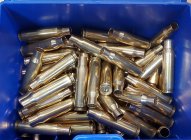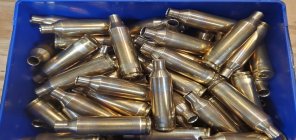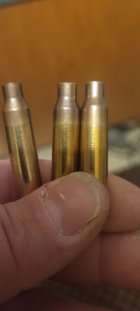You are using an out of date browser. It may not display this or other websites correctly.
You should upgrade or use an alternative browser.
You should upgrade or use an alternative browser.
Induction Annealing Results With Tempilaq
- Thread starter Bidwell
- Start date
Sorry if its a dumb question but what is zero annealing? How does your 750 tempilaq react when it hits temp? Mine just turns kinda dark. It doesn't have a very clear melt like my 450 does. My 1000f just turns darker red.Y
ou should be getting close to zero annealing at 750F for a fraction of a second.
Zero annealing means no hardness change.Sorry if its a dumb question but what is zero annealing? How does your 750 tempilaq react when it hits temp? Mine just turns kinda dark. It doesn't have a very clear melt like my 450 does. My 1000f just turns darker red.
Got it, thanks!Zero annealing means no hardness change.
Should my cases have a darker color to them. I dont have anything or person to measure the hardness. I am here to learnY
You should be getting close to zero annealing at 750F for a fraction of a second.
Attachments
jthor
USAF Shooting Team
Annealing color change means nothing other than the surface of the brass was oxidized and got hot.Should my cases have a darker color to them. I dont have anything or person to measure the hardness. I am here to learn
Webster is correct. Getting to 750 won’t anneal brass in seconds. Getting to that dim red glow with the lights off, which is around 900F. Brass annealing temp and time needed have an inverse relationship. The hotter you go the less time you need. I don’t have a chart infront of me, but as an “about” it takes brass about an hour to anneal at 600F, a minute or so at 750F and in the seconds around 900F. That’s not an exact science, but close enough.
When folks in the past have been using templaq they were letting it get hot enough to where the templaq melted 1/8-1/4” below the shoulder of the case onto the body. In that case, no pun intended, by the time then templaq melted 1/8-1/4” below the shoulder the neck was certainly way hotter than 750 and closer to the 900 mark. Annealing brass your trying to isolate the heat to the neck and shoulder which is why you want to heat it up so fast. That being said, the templaq method isn’t needed. Just use the dim glow method and you’re good.
Lastly I will say with induction annealing it is incredibly important that each piece of brass is centered in the coil and placed in the same height. Once induction starts it will self center the brass, but it can’t self center the height.
As said above, the color really doesn't mean anything. Though what you see is an indication how far the heat had traveled down the case and from what I see you're I'd say ok with regards to this. Even with an induction annealer, the "glow method" can give you a good idea how hot you're actually getting the necks to.Should my cases have a darker color to them. I dont have anything or person to measure the hardness. I am here to learn
This is exactly the info i needed to understand and will learn from. At times i had brass that turned dark and was worried that i did to much but this was from fired brass. Maybe carbon I believe would cause that. I do my best to keep the brass centered and have noticed if it isnt one side gets hotter faster. I drink lots of coffe when i am annealing lol jk. Taking note of this in my book. You would happen to have a picture of what correctly annealed brass looks like. Just curious is it makes a difference with the surface color looks like. Thank you fot the infoAnnealing color change means nothing other than the surface of the brass was oxidized and got hot.
Webster is correct. Getting to 750 won’t anneal brass in seconds. Getting to that dim red glow with the lights off, which is around 900F. Brass annealing temp and time needed have an inverse relationship. The hotter you go the less time you need. I don’t have a chart infront of me, but as an “about” it takes brass about an hour to anneal at 600F, a minute or so at 750F and in the seconds around 900F. That’s not an exact science, but close enough.
When folks in the past have been using templaq they were letting it get hot enough to where the templaq melted 1/8-1/4” below the shoulder of the case onto the body. In that case, no pun intended, by the time then templaq melted 1/8-1/4” below the shoulder the neck was certainly way hotter than 750 and closer to the 900 mark. Annealing brass your trying to isolate the heat to the neck and shoulder which is why you want to heat it up so fast. That being said, the templaq method isn’t needed. Just use the dim glow method and you’re good.
Lastly I will say with induction annealing it is incredibly important that each piece of brass is centered in the coil and placed in the same height. Once induction starts it will self center the brass, but it can’t self center the height.
Again . . . what the brass looks like after the annealing process is not any indication of what is "correctly annealed". Any of that discoloration can be washed away, as you can see in this pic below that I just took of my brass that's been fired 15 times and was anneal "correctly" after every firing to the the ideal hardness (being what I feel what virgin Lapua cases are annealed to). This brass was discolored after annealing having powder residue left on the necks and only dry tumbled in the past and then wet tumbled without any media (no SS pins and just hot water and Dawn). I very seldom wet tumble my brass, but decided to make them look pretty after the 15 firings.This is exactly the info i needed to understand and will learn from. At times i had brass that turned dark and was worried that i did to much but this was from fired brass. Maybe carbon I believe would cause that. I do my best to keep the brass centered and have noticed if it isnt one side gets hotter faster. I drink lots of coffe when i am annealing lol jk. Taking note of this in my book. You would happen to have a picture of what correctly annealed brass looks like. Just curious is it makes a difference with the surface color looks like. Thank you fot the info

Here's some 6.5 PRC cases that were not wet tumbles, but were dry tumbled after annealing and sizing:

Ahhhh makes perfect sense now I never payed attention when cleaning range brass. Time under heat is all that matters. Thanks for dumbing it down for me. Back of my brain was looking for a reference pic. WillAgain . . . what the brass looks like after the annealing process is not any indication of what is "correctly annealed". Any of that discoloration can be washed away, as you can see in this pic below that I just took of my brass that's been fired 15 times and was anneal "correctly" after every firing to the the ideal hardness (being what I feel what virgin Lapua cases are annealed to). This brass was discolored after annealing having powder residue left on the necks and only dry tumbled in the past and then wet tumbled without any media (no SS pins and just hot water and Dawn). I very seldom wet tumble my brass, but decided to make them look pretty after the 15 firings.
View attachment 1615038
Here's some 6.5 PRC cases that were not wet tumbles, but were dry tumbled after annealing and sizing:
View attachment 1615039
Similar threads
- Replies
- 32
- Views
- 1,681
Upgrades & Donations
This Forum's expenses are primarily paid by member contributions. You can upgrade your Forum membership in seconds. Gold and Silver members get unlimited FREE classifieds for one year. Gold members can upload custom avatars.

Click Upgrade Membership Button ABOVE to get Gold or Silver Status.
You can also donate any amount, large or small, with the button below. Include your Forum Name in the PayPal Notes field.
To DONATE by CHECK, or make a recurring donation, CLICK HERE to learn how.

Click Upgrade Membership Button ABOVE to get Gold or Silver Status.
You can also donate any amount, large or small, with the button below. Include your Forum Name in the PayPal Notes field.
To DONATE by CHECK, or make a recurring donation, CLICK HERE to learn how.










